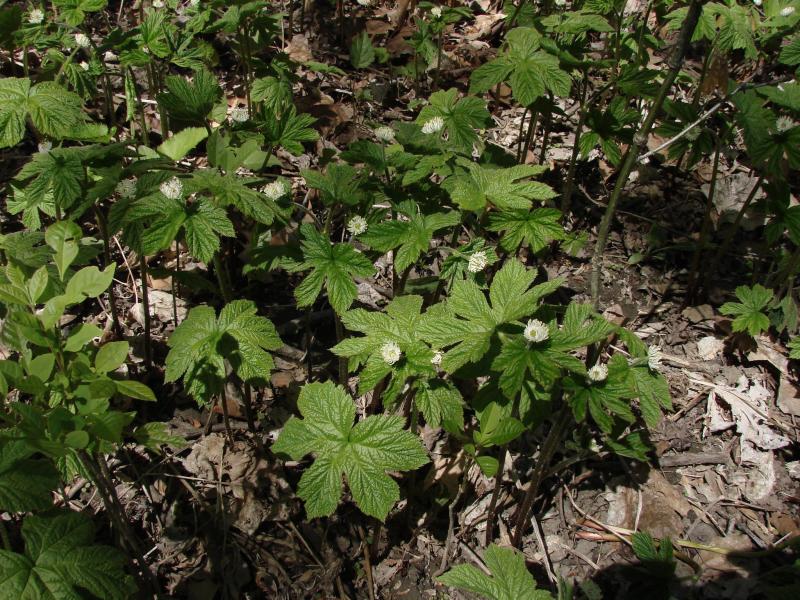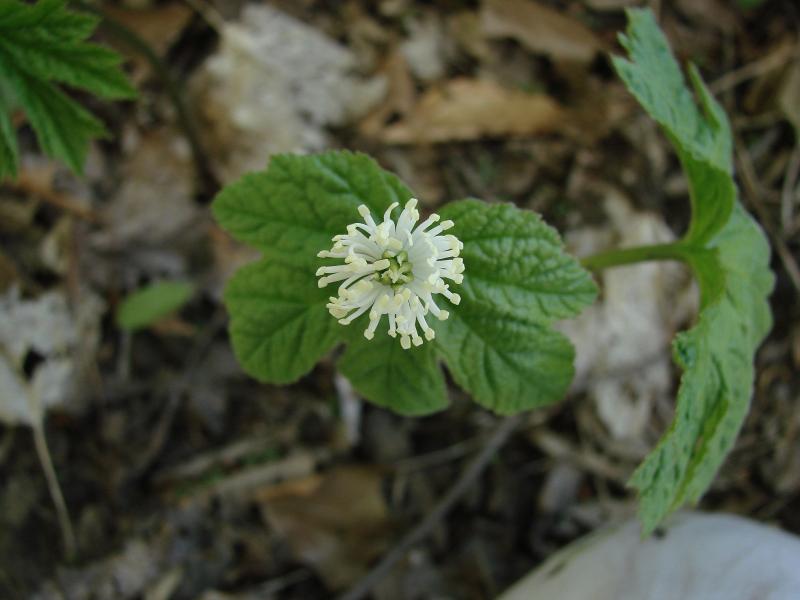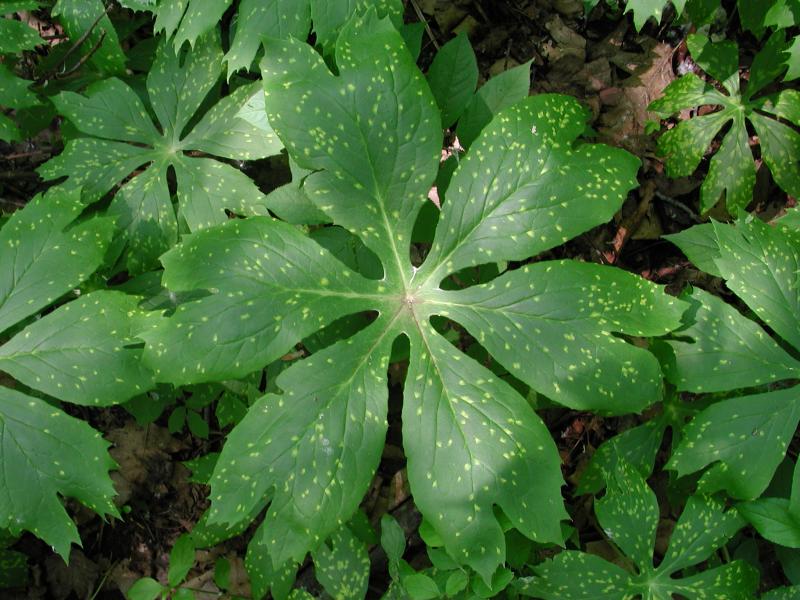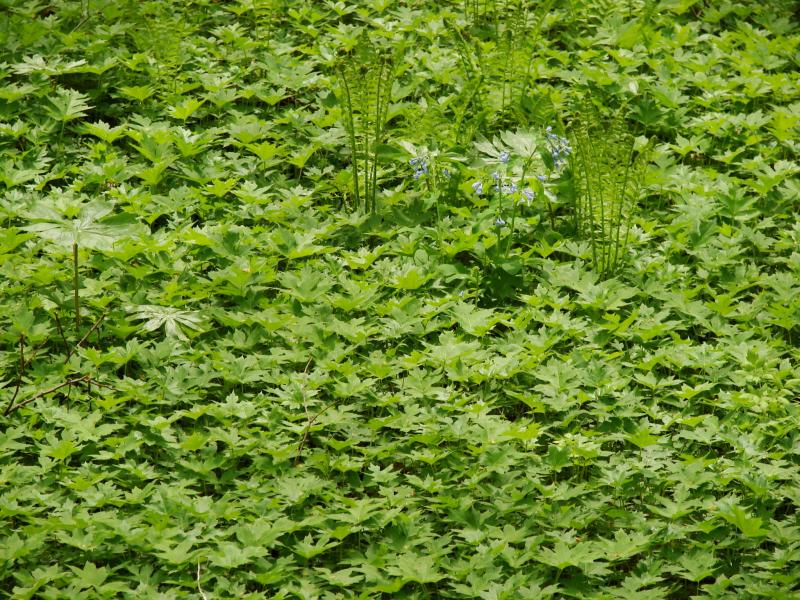Goldenseal
Hydrastis canadensis L.
- Class
- Dicotyledoneae (Dicots)
- Family
- Ranunculaceae (Buttercup Family)
- State Protection
- Threatened
Listed as Threatened by New York State: likely to become Endangered in the foreseeable future. For animals, taking, importation, transportation, or possession is prohibited, except under license or permit. For plants, removal or damage without the consent of the landowner is prohibited.
- Federal Protection
- Not Listed
- State Conservation Status Rank
- S2
Imperiled in New York - Very vulnerable to disappearing from New York due to rarity or other factors; typically 6 to 20 populations or locations in New York, very few individuals, very restricted range, few remaining acres (or miles of stream), and/or steep declines.
- Global Conservation Status Rank
- G3G4
Vulnerable globally, or Apparently Secure - At moderate risk of extinction, with relatively few populations or locations in the world, few individuals, and/or restricted range; or uncommon but not rare globally; may be rare in some parts of its range; possibly some cause for long-term concern due to declines or other factors. More information is needed to assign either G3 or G4.
Summary
Did you know?
Goldenseal is highly valued for its medicinal properties and is now becoming more rare range-wide because it is being overcollected. Fortunately, it can also be grown in a nursery without disturbing wild populations.
State Ranking Justification
There are 20 existing populations and about 10 historical records. It is not expected that many more populations will be found and that the threat from collection and habitat destruction may increase in the future.
Short-term Trends
One site in eastern New York has been severely degraded but populations remain fairly stable throughout the rest of state.
Long-term Trends
Historical records show that this plant was never common in New York and the number of known occurrences has remained about the same over the last 100 years.
Conservation and Management
Threats
This plant is collected for medicinal purposes but so far there is no evidence that it is being over-collected in New York. There is a moderate threat from habitat destruction, especially in the Lower Hudson area. Exotic species like garlic mustard and bush honeysuckle threaten its understory habitat.
Conservation Strategies and Management Practices
The woodland areas where this species occurs need to be protected from disturbance that could introduce too much sunlight or invasive species to the site. If there are invasive species they need to be removed.
Research Needs
Some research has been done on habitat preference by the College of Environmental Science and Forestry but there have been no results as of 2007. Research needs to be done on whether populations could be augmented at existing sites.
Habitat
Habitat
Goldenseal colonies are found at the bottom or mid-slopes of rich woodlands, often near streams. Sometimes the slopes are deeply dissected by runoff or they may consist of limestone talus and cliffs. The forests are usually mature with old logs and an open understory with a diverse Spring wildflower flora. The underlying rock is usually limestone and the soils are rich in organic matter, sometimes with springs emanating from the slopes. (New York Natural Heritage Program 2007). Deep rich woods (Fernald 1970). Deep rich woods (Gleason 1952).
Associated Ecological Communities
- Calcareous talus slope woodland
(guide)
An open or closed canopy community that occurs on talus slopes composed of calcareous bedrock such as limestone or dolomite. The soils are usually moist and loamy; there may be numerous rock outcrops.
- Floodplain forest
(guide)
A hardwood forest that occurs on mineral soils on low terraces of river floodplains and river deltas. These sites are characterized by their flood regime; low areas are annually flooded in spring, and high areas are flooded irregularly.
- Limestone woodland
(guide)
A woodland that occurs on shallow soils over limestone bedrock in non-alvar settings, and usually includes numerous rock outcrops. There are usually several codominant trees, although one species may become dominant in any one stand.
- Maple-basswood rich mesic forest
(guide)
A species rich hardwood forest that typically occurs on well-drained, moist soils of circumneutral pH. Rich herbs are predominant in the ground layer and are usually correlated with calcareous bedrock, although bedrock does not have to be exposed. The dominant trees are sugar maple, basswood, and white ash.
- Oak-tulip tree forest
(guide)
A hardwood forest that occurs on moist, well-drained sites in southeastern New York. The dominant trees include a mixture of five or more of the following: red oak, tulip tree, American beech, black birch, red maple, scarlet oak, black oak, and white oak.
Associated Species
- Acer nigrum (black maple)
- Acer saccharum (sugar maple)
- Adiantum pedatum (maidenhair fern)
- Ageratina altissima
- Alliaria petiolata (garlic mustard)
- Allium tricoccum
- Amphicarpaea bracteata (hog peanut)
- Arisaema triphyllum
- Asarum canadense (wild ginger)
- Athyrium filix-femina
- Betula papyrifera (paper birch)
- Cardamine concatenata (cut-leaved toothwort)
- Cardamine diphylla (two-leaved toothwort)
- Carex platyphylla (broad-leaved sedge)
- Carpinus caroliniana
- Carya cordiformis (bitternut hickory)
- Carya laciniosa (kingnut hickory, big shellbark hickory)
- Caulophyllum thalictroides (blue cohosh, late blue cohosh)
- Claytonia virginica (eastern spring-beauty)
- Collinsonia canadensis (stoneroot, horse-balm)
- Cornus florida (flowering dogwood)
- Cryptotaenia canadensis (honewort)
- Cystopteris bulbifera (bulblet fern)
- Deparia acrostichoides (silvery spleenwort)
- Equisetum arvense (field horsetail, common horsetail)
- Erythronium albidum (white trout-lily)
- Eurybia divaricata (white wood-aster)
- Fagus grandifolia (American beech)
- Fraxinus americana (white ash)
- Galium circaezans (forest wild-licorice)
- Geranium maculatum (wild geranium)
- Hamamelis virginiana (witch-hazel)
- Hepatica nobilis
- Jeffersonia diphylla (twinleaf)
- Lindera benzoin (spicebush)
- Liriodendron tulipifera (tulip tree, tulip poplar, yellow poplar)
- Magnolia acuminata (cucumber tree, cucumber magnolia)
- Maianthemum racemosum
- Matteuccia struthiopteris
- Menispermum canadense (moonseed)
- Ostrya virginiana (hop hornbeam, ironwood)
- Parthenocissus quinquefolia (Virginia-creeper)
- Phegopteris hexagonoptera (broad beech fern)
- Pinus strobus (white pine)
- Podophyllum peltatum (may-apple)
- Polygonatum pubescens (hairy Solomon's-seal)
- Polymnia canadensis (leaf-cup)
- Prunus serotina
- Prunus virginiana
- Quercus alba (white oak)
- Quercus rubra (northern red oak)
- Ranunculus abortivus (kidney-leaved butter-cup, kidney-leaved crow-foot)
- Sanguinaria canadensis (bloodroot)
- Solidago caesia
- Solidago flexicaulis (zig-zag goldenrod)
- Staphylea trifolia (bladdernut)
- Symplocarpus foetidus (skunk-cabbage)
- Thalictrum dioicum (early meadow-rue)
- Thelypteris noveboracensis (New York fern)
- Tilia americana
- Toxicodendron radicans
- Trillium erectum (purple trillium, stinking Benjamin)
- Trillium grandiflorum (white trillium)
- Tsuga canadensis (eastern hemlock)
- Ulmus rubra (slippery elm)
- Uvularia grandiflora (large-flowered bellwort)
- Uvularia sessilifolia (wild-oats, sessile-leaved bellwort)
- Viburnum acerifolium (maple-leaved viburnum)
- Viola rostrata (long-spurred violet)
Range
New York State Distribution
Goldenseal occurs from Rennselaer County south to Orange and Dutchess Counties and west to Niagara and Erie Counties. Most collections are from western New York.
Global Distribution
Goldenseal occurs from the Eastern United States northward into Ontario. It is common in Arkansas, Indiana, Illinois, Kentucky, Missouri, Ohio, and West Virginia and uncommon around the range perimeter. Hydrastis is presently cultivated to a limited extent within its historical range as well as in Oregon and Washington (Kauffman 1996).
Identification Comments
General Description
A small herbaceous plant usually growing in groups with one small leaf at the bottom and two large leaves at the top of the hairy stem. The leaves are heart-shaped with five-seven toothed lobes. There is one flower at the top of the stem composed of showy white stamens. This matures into a round cluster of showy red berries.
Best Life Stage for Proper Identification
It is best to search for this plant when the leaf is present with a flower or fruit. However, the distinctive leaves can be used for identification when flowers and fruits are absent.
Similar Species
This species may be confused for Mayapple, Podophyllum peltatum, or Canada waterleaf, Hydrophyllum canadense, when not in flower. Mayapple has a peltate leaf with lobes that are split into two smaller lobes at the tip and a single white flower blooms below the leaves. Canada waterleaf has lobes with larger teeth and a very rough surface and the light lavender flowers bloom in clusters just below the leaf blades.
Best Time to See
Hydrastis canadensis flowers in May. Its red fruits mature June through August.
- Vegetative
- Flowering
- Fruiting
The time of year you would expect to find Goldenseal vegetative, flowering, and fruiting in New York.
Goldenseal Images
Images of Similar Species
Taxonomy
Goldenseal
Hydrastis canadensis L.
- Kingdom Plantae
- Phylum Anthophyta
- Class Dicotyledoneae
(Dicots)
- Order Ranunculales
- Family Ranunculaceae (Buttercup Family)
- Order Ranunculales
- Class Dicotyledoneae
(Dicots)
- Phylum Anthophyta
Additional Common Names
- Orange-root
- Yellow Puccoon
Synonyms
- Warnera canadensis (L.) Mill.
Additional Resources
Best Identification Reference
Gleason, Henry A. and A. Cronquist. 1991. Manual of Vascular Plants of Northeastern United States and Adjacent Canada. The New York Botanical Garden, Bronx, New York. 910 pp.
Other References
Bannerman, J. 1997. The goldenseal dilemma: Saving the plant that heals. The Institute of Conservation & Culture, New Orleans, Louisiana. Manuscript in preparation.
Benigni, R., et al. 1962. Piante Medicinali-Chimica, Farmacologia e Terapia, Vol. 1. Inverni & Della Beffa, Milan.
Bradley, P., ed. 1992. British Herbal Compendium, Vol. 1. British Herbal Medical Association, Dorset, U.K.
Brevoort, P. 1996. The U.S. botanical market: An overview. HerbalGram No. 36: 49-57.
CITES. 1997. Amendments to Appendices I and II of the Convention on Internation Trade in Endangered Species and Wild Fauna and Flora. Online. http://international.fws.gov/cop10/gseal97.html. 14 January 2000.
Catling, P.M. and Small, E. 1994. Poorly known economic plants of Canada. 3. Hydrastis canadensis L. CBA/ABC Bull. 27(3): 50-51.
Crow, G.E. 1982. New England's rare, threatened, and endangered plants. USWFS Northeast Region, Newton Corners, MA.
Deam, C. C. 1940. Flora of Indiana. Division of Forestry, Dept. of Conservation, Indianapolis, Indiana. 1236 pp.
Elliott, D. 1995. Wild Roots: A Forager's Guide to the Edible and Medicinal Roots, Tubers, Corms, and Rhizomes of North America. Healing Arts Press, Rochester, Vermont. Pp. 30-31.
Fernald, M. L. 1950. Gray's manual of botany. 8th edition. Corrected printing (1970). D. Van Nostrand Company, New York. 1632 pp.
Fernald, M.L. 1950. Gray's manual of botany. 8th edition. D. Van Nostrand, New York. 1632 pp.
Foster, S. 1991. Goldenseal, Hydrastis canadensis. American Botanical Council, Botanical Series No. 309. 8 pp.
Foster, S. 1995. Forest Pharmacy: Medicinal Plants in American Forests. Forest History Society, Durham, North Carolina.
Gleason, H.A. 1968. The New Britton and Brown Illustrated Flora of the Northeastern United States and Adjacent Canada. Vol. 3. The Sympetalous Dicotyledoneae. Hafner Publishing Co., Inc., New York.
Grieve, M. 1971. A Modern Herbal, Vol. 1-2. Dover Publications Inc., New York, New York. 888 p.
Henkel, A., and G.F. Klugh. 1904. Golden seal. U.S. Dept. Agric., Bureau of Plant Industry, Bull. No. 51, Part 6. 16 pp.
Hill, A.F. 1952. Economic Botany, 2nd edition. McGraw-Hill Book Co., New York. 560 pp.
Holmgren, Noel. 1998. The Illustrated Companion to Gleason and Cronquist's Manual. Illustrations of the Vascular Plants of Northeastern United States and Adjacent Canada. The New York Botanical Garden, Bronx, New York.
House, Homer D. 1924. Annotated list of the ferns and flowering plants of New York State. New York State Museum Bulletin 254:1-758.
Kaneda, Y. 1991. In vitro effects of berberine sulfate on the growth of Entamoeba histolytica, Giardia lamblia and Tricomonas vaginalis. Ann. Trop. Med. Parasitol. 85: 417-425.
Kartesz, J.T. 1999. A synonymized checklist and atlas with biological attributes for the vascular flora of the United States, Canada, and Greenland. First edition. In: Kartesz, J.T., and C.A. Meacham. Synthesis of the North American Flora, Version 1.0. North Carolina Botanical Garden, Chapel Hill, N.C.
Kauffman, G. 1996. Biological White Paper on Hydrastis canadensis. North Carolina. Manuscript in preparation.
Liu, C.X. 1991. Studies on plant resources, pharmacology and clinical treatment with berberine. Phytother. Res. 5: 228-230.
Lloyd, J.U. and C.G. Lloyd. 1884-1885. Drugs and Medicines of North America, Vol. 1, Ranunculaceae. Clarke, Cincinnati, Ohio. 304 pp.
Lloyd, J.U., and C.G. Lloyd. 1908. Hydrastis canadensis. Bull. Lloyd Library of Botany, Pharmacy and Materia Medica 10. 184 pp.
McGuffin, Michael. Personal communication. American Herbal Products Association, Silver Spring MD
Medical Sciences Bulletin. 1996 (Oct.). Treatment Options for HIV: The Health Food Store Connection. Online: PharmInfoNet Home Page.
Mills, S.Y. 1991. Out of the Earth: The Essential Book of Herbal Medicine. Viking, London. Pp. 439-441. Millspaugh, C.F. 1887 [1974]. American Medicinal Plants. Dover Publications, New York, p. 9-2.
Mitchell, R.S. 1982. Recovery plan and status of northern monk's-hood (Aconitum noveboracense) in New York State.
Mitchell, Richard S. and Gordon C. Tucker. 1997. Revised Checklist of New York State Plants. Contributions to a Flora of New York State. Checklist IV. Bulletin No. 490. New York State Museum. Albany, NY. 400 pp.
Murray, M. 1995. The Healing Power of Herbs. Prima, Rocklin, Calif. Pp. 162-172.
New York Natural Heritage Program. 2024. New York Natural Heritage Program Databases. Albany, NY.
Planet Herbs. 1999. Planet Herbs: Natural botanicals wholesale. Online. Available: http://www.planetherbs.net. Accessed 2000-Jan.
Reschke, Carol. 1990. Ecological communities of New York State. New York Natural Heritage Program, New York State Department of Environmental Conservation. Latham, NY. 96 pp. plus xi.
Sack, R.B. and Froehlich, J.L. 1982. Berberine inhibits intestinal secretory response of Vibrio cholerae toxins and E. coli enterotoxins. Infect. Immun. 35: 471-475.
Schery, R.W. 1972. Plants for Man, 2nd edition. Prentice-Hall, Englewood Cliffs, New Jersey. 657 pp.
Smith, Gerald A. No date. Bird breeding season survey at El Dorado Beach Preserve 1981-.
Sun, D. 1988. Berberine sulfate blocks adherence of Streptococcus pyogenes to epithelial cells, fibronectin, and hexadecane. Antimicrob. Agents Chemother. 32: 1370-1374.
Veninga, L. and B. Zaricor. 1976. Goldenseal/Etc: A Pharmacognosy of Wild Herbs. Ruka Publications, Santa Cruz.
Weldy, T. and D. Werier. 2010. New York flora atlas. [S.M. Landry, K.N. Campbell, and L.D. Mabe (original application development), Florida Center for Community Design and Research http://www.fccdr.usf.edu/. University of South Florida http://www.usf.edu/]. New York Flora Association http://newyork.plantatlas.usf.edu/, Albany, New York
Wofford, B.E. 1989. Guide to vascular plants of the Blue Ridge. University of Georgia Press. Athens, Georgia.
Links
About This Guide
Information for this guide was last updated on: January 13, 2009
Please cite this page as:
New York Natural Heritage Program. 2024.
Online Conservation Guide for
Hydrastis canadensis.
Available from: https://guides.nynhp.org/goldenseal/.
Accessed July 26, 2024.




